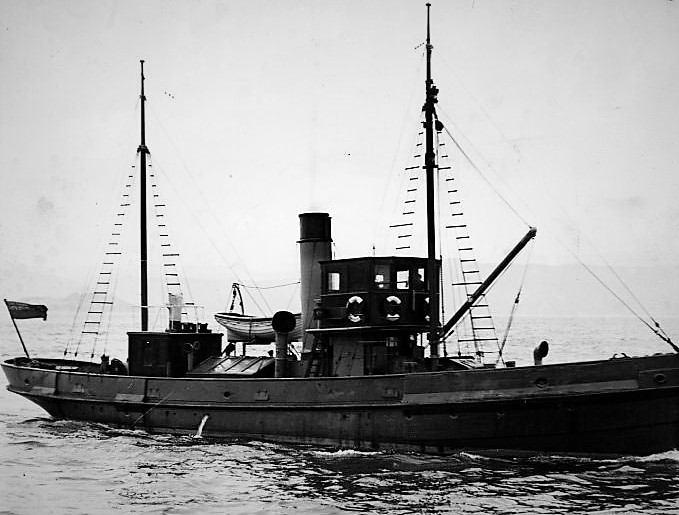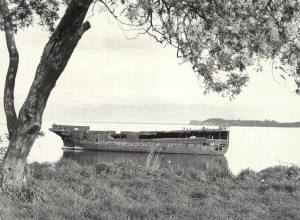The SS Janie Seddon – laid to rust
The steamship Janie Seddon was built in 1901 by Fleming & Ferguson Ltd at Paisley in Scotland. A vessel of 125 tons, she was powered by two horsepower steam engines and was a twin-screw (two propellers) steamship.
The steamship Janie Seddon was built in 1901 by Fleming & Ferguson Ltd at Paisley in Scotland.
A vessel of 125 tons, she was powered by two horsepower steam engines and was a twin-screw (two propellers) steamship.(1)
She was reportedly named after the wife of Richard John (King Dick) Seddon, Premier of New Zealand from 1893 to 1906. (2)
Janie Seddon and her sister ship, the Lady Roberts, were specifically designed to be used for laying submarine mines and they were both bought by the New Zealand Government for that purpose. The two vessels steamed out to New Zealand together, arriving in Wellington in January 1902. Lady Roberts went to Auckland while Janie Seddon stayed in Wellington, where she was used by the Royal New Zealand Engineers to lay submarine mines around the harbour entrance to Wellington.
During World War I and World War II, Janie Seddon was used as a harbour examination vessel, which included inspecting any incoming vessels and mine sweeping. She also served the internment and prisoner-of-war camp on Matiu / Somes Island in World War I. (3)
At the start of World War II, she reputedly fired the first shot when a vessel, City of Delhi, entered Wellington Harbour without stopping on request. (4)
After World War II, in 1946, she was purchased by the Motueka Trawling Company Ltd, as the first vessel bought by Ivan Talley, founder of Talley’s Fisheries Ltd. Command was given to Captain Albert Nalder to sail the vessel from Wellington to Motueka, where she was converted from a submarine laying steamship to a fishing vessel. (5)
Her life as a fishing vessel, however, proved to be unsuccessful, as she was too big to trawl inside the 3-mile mark, which was rich in snapper and had to work outside the Tasman Bay / Te Tai-o-Aorere. She also had a relatively small coal bunker, which only allowed a maximum of five days at sea.
Janie Seddon became a financial loss for Ivan Talley and his company. In 1948 her fishing days came to an end, and she was laid up at the Motueka Wharf. (6)
After sinking at her moorings a few years later she was broken up for scrap. She was left partly dismantled at her present site on the mudflats close to the site of the old Motueka Wharf.
Today, Janie’s rusting hull remains a picturesque attraction on the Motueka waterfront with the tide washing past and seagulls for company.
August 2022
Story by: Tasman Libraries
Sources
- Images of Janie. (1997). Motueka: Motueka District Museum in conjunction with ‘The images of Janie’ exhibition, July 1997. p.1.
https://worldcat.org/en/title/813400250 - Shipping Overseas & Coastal. (1930, September 9). Star (Christchurch), p.2.
https://paperspast.natlib.govt.nz/newspapers/TS19300909.2.37 - Makarios E. & Wellington Maritime Museum. (1996). Nets lines and pots : a history of New Zealand fishing vessels. IPL Books in association with Wellington Maritime Museum. p.13-14.
https://worldcat.org/en/title/38218709 - Dawber Carol and Motueka and Districts Historical Association. (2016). Motueka Wharf 100 Years. Picton: River Press (October Enterprises Ltd). p.99.
https://worldcat.org/en/title/945797238 - Makarios, p. 14.
- Mackay, Deirdre. (2004). Voices from the sea: the stories of some Nelson and Marlborough fishing families. Motueka. Talley’s Group.p.36-37.
https://worldcat.org/en/title/156320460
Further Sources
Books
- Dawber, Carol (2016). Motueka wharf, 100 years. Picton (New Zealand): River Press (October Enterprises Ltd).
https://www.worldcat.org/title/945797238 - Mackay, Deirdre (2004). Voices from the sea: the stories of some Nelson and Marlborough fishing families. Motueka, N.Z., Talley’s Group.
https://www.worldcat.org/title/156320460 - Makarios, Emmanuel (1996). Nets, lines and pots: a history of New Zealand fishing vessels. Vol. 1. Wellington, N.Z., IPL Books in association with Wellington Maritime Museum.
https://www.worldcat.org/title/38218709
Websites
- The Government Fleet. Arrival of the Submarine Mining Boats. (1902, January 16). Evening Post, Page 6.
https://paperspast.natlib.govt.nz/newspapers/EP19020116.2.53 - Shipping Overseas & Coastal. (1930, September 9). Star (Christchurch), Page 2.
https://paperspast.natlib.govt.nz/newspapers/TS19300909.2.37 - Big Guns in Action. (1936, February 14). Evening Post, Page 7.
https://paperspast.natlib.govt.nz/newspapers/EP19360214.2.47.1 - The Janie Seddon sold. (1946, December 13). Press, Page 3.
https://paperspast.natlib.govt.nz/newspapers/CHP19461213.2.12
Maps
- Images of Janie (1997). Booklet produced by the Motueka District Museum in conjunction with ‘The images of Janie’ exhibition, July 1997.

